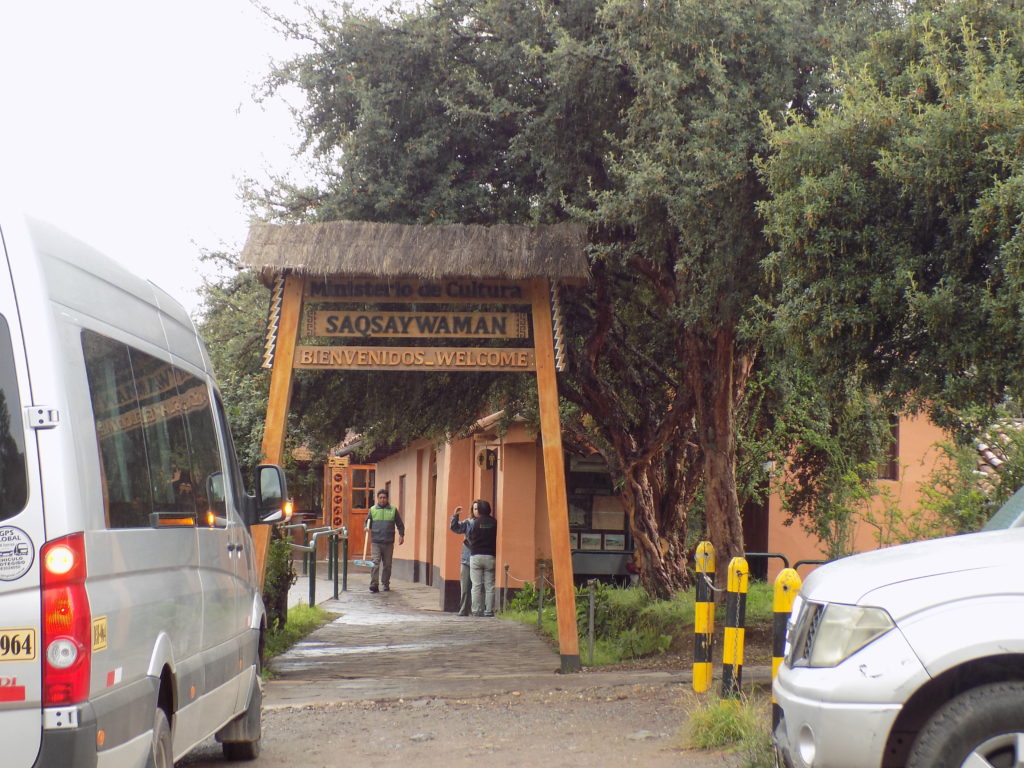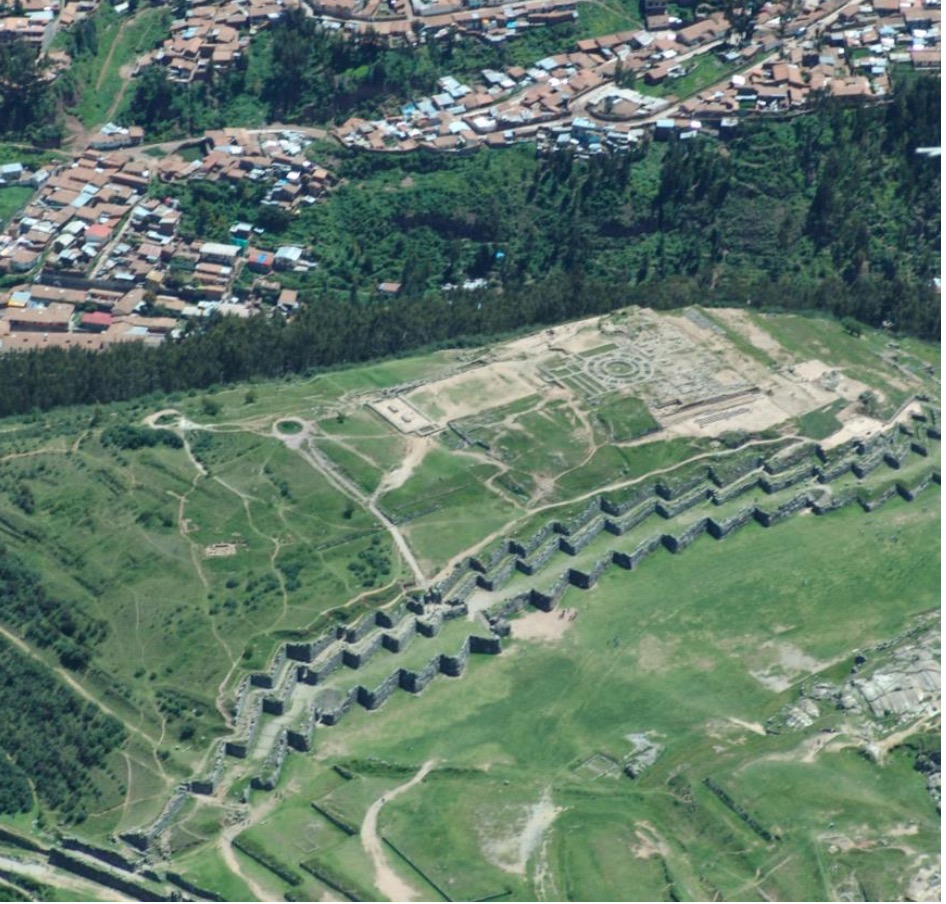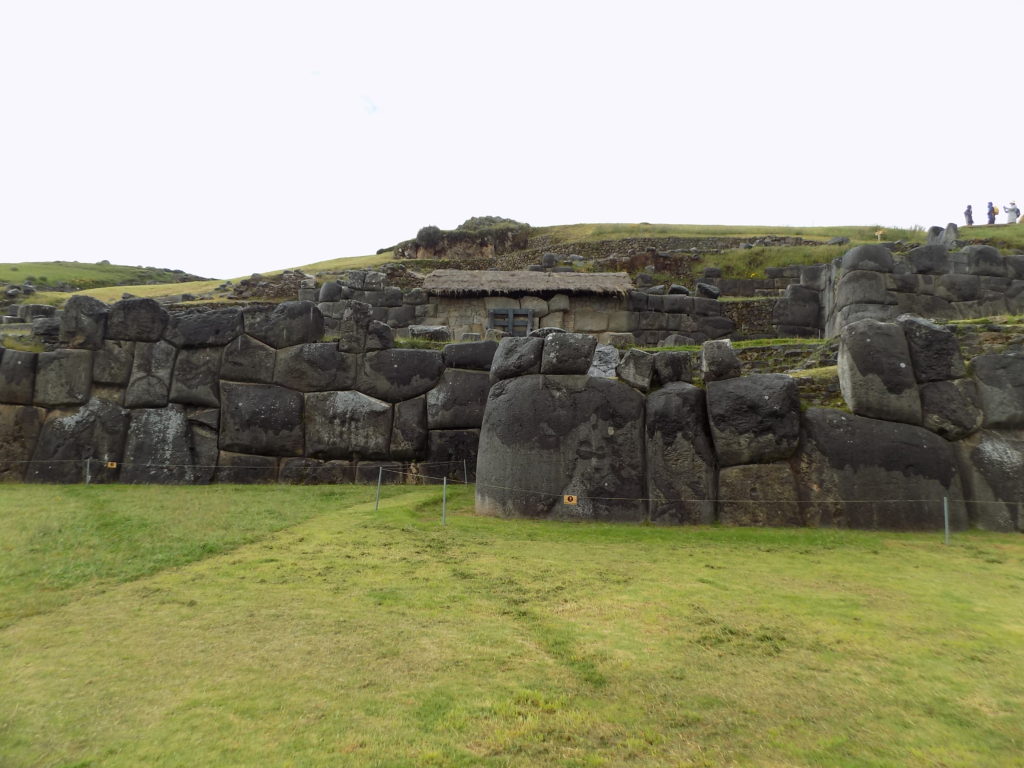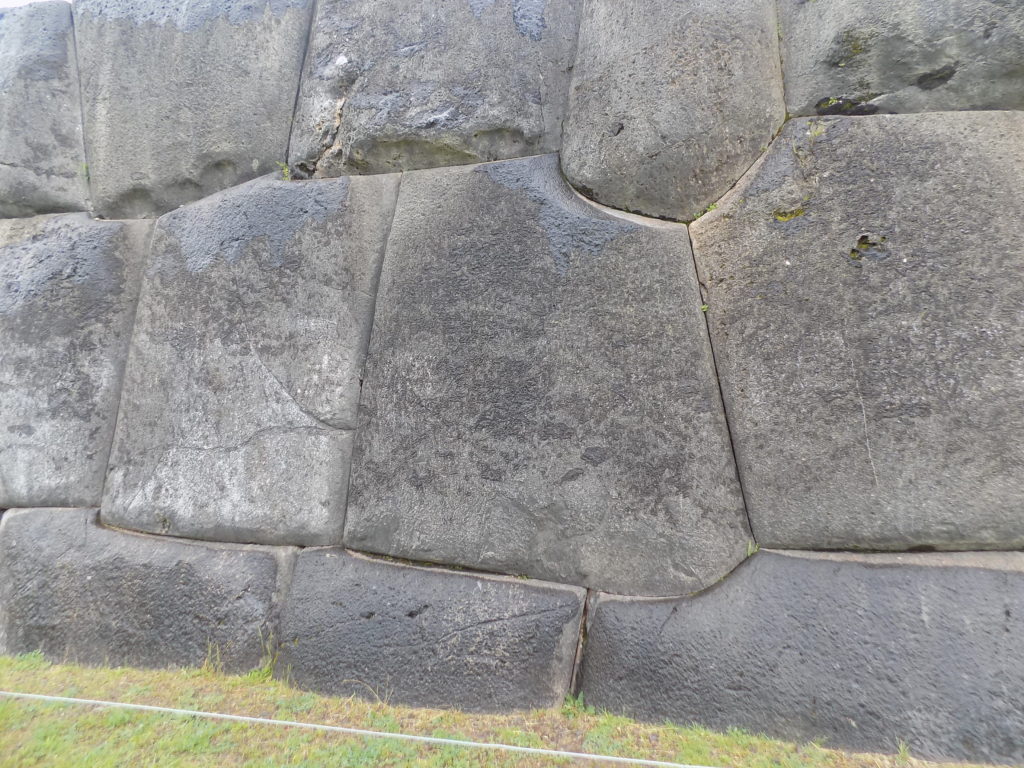Spelling is one of the challenges of replicating names from a language that, if it had an orthography, would still have been alien to the system we use in the west which is why you might have seen and might see some inconsistencies by me in that area. With Berner, who is a Cusco native, serving as our guide, we left the hotel on a rainy Tuesday morning for a 15-minute drive to an important citadel in the hills north of the city. As I sit to write about it, I have to decide on a transliteration. Here (absent footnote references and hyperlinks) is the first sentence on the site’s Wikipedia page:
“Sacsayhuamán, Sacsayhuaman, Sacsahuaman, Saxahuaman, Saksaywaman, Saqsaywaman, Sasawaman, Saksawaman, Sacsahuayman, Sasaywaman or Saksaq Waman (possibly from Quechua language, waman falcon or variable hawk) is a citadel on the northern outskirts of the city of Cusco, Peru, the historic capital of the Inca Empire.”
It offers 11 alternative spellings. However, because of this sign 
I’m inclined to use the sixth option on that list. If you’re curious, the closest approximation of its pronunciation I can muster would be “sock-Sigh-WAH-mn.” While the sign is a helpful reminder, I wouldn’t always have access to the photo so I found it challenging to recall this Quechua place name.
For me, Quechua is a truly foreign language. Not only had I had no exposure to it before this trip but, as far I as could tell, it lacked cognates that could serve as small Velcro like hooks and attach themselves to the larger English hooks already lodged in my brain. (For example, when I see the Spanish word sopa on a menu in a restaurant in Perú or Bolivia it’s a close enough cognate of soup – its English counterpart – to make it easy to recall.) It was Jill who creatively linked Saqsaywaman with the English phrase “sexy woman” and generated not only a nearly ideal mnemonic but a blog post title too. I now had a large hook to help me recall this place.
Saqsaywaman.
The earliest construction on the site probably occurred long before the Inkas arrived. This work was done by the Killke culture probably sometime in the 12th century but it was under the rule of Pachakutiq that the expansion of the site began in earnest.
If, as some have speculated, Pachakutiq wanted Cusco to be a designed city shaped as a puma, the hill north of the city center on which Saqsaywaman sat was a natural site for the symbolic head. The site itself is huge, the construction is massive, and it’s estimated that its completion required half a century. (This should be unsurprising. The Inkas didn’t use the wheel and had no animals that could assist them. It was sheer numbers of people and, as despair.com‘s Achievement poster reminds us, “You can do anything you set your mind to when you have vision, determination, and an endless supply of expendable labor.”) While our visit concentrated mainly on the area near the three concentric rings called Muyuqmarka where the main tower was situated, this aerial view from The American Surveyor provides some sense of the size of the complex which covers about 10 hectares.
The sight of a series of three large stone walls along the northern base of the hill rising as tall as six meters and extending about 360 meters makes it understandable why Saqsaywaman is often described as a fortress. Its use for that purpose by the Inkas in the battle for Cusco against the Spaniards certainly reinforced and perpetuated that view but it’s unlikely that this was its primary historical use. Recall that residence in the city was generally limited to nobility, priests, and administrators so as a starting point we should have no reason to suspect that the complex at Saqsaywaman would have been used for other than the purposes those positions demanded.
A multi-purpose facility.
The complex housed several temples including a major one devoted to the sun god Inti. Like most ancient societies around the world, the Inkas relied on what our western chauvinism often tabs as surprisingly sophisticated local and astronomical knowledge to guide their people. Limiting access and protecting such knowledge was in the interests of the shamans and rulers who had access to it (in much the same way that Europe’s stone masons protected their construction secrets or its priests used limited literacy to control their flocks). Thus, if Saqsaywaman appears to be well protected and have limited access, it was likely serving as much to protect the secrets of the powerful as it was serving a military purpose.
It was also likely constructed to protect much of the material housed within its walls. The Saqsaywaman complex served as a storehouse for precious metals and gems (mainly used to adorn temples and some of which would probably have been used on the exterior of walls at the site), weapons, textiles and fine clothing, and ceramics. It also served as a warehouse for food against times of poor harvests.
The more we learn about the Inkas, the more their reputation grows as master builders and engineers and, although only the foundations remain, the Saqsaywaman complex provides a fuller picture of their accomplishments.
(Beginning with the Spanish conquest, Saqsaywaman was effectively dismantled. Doctor Richard Miksad of the University of Virginia school of Engineering has done extensive work at the site and described the destructive process, “They wanted to wipe away all vestiges of the Inca culture so that no one knew what was once there. For 400 years it was a rubble pile used as a quarry for the construction of colonial Cusco. Local government sold cheap permits that entitled – even encouraged – people to haul stone from the site.”
Compounding the loss of this marvel, the Spanish ordered many of the ruins covered in mud to prevent their reuse and reclamation by any remaining recalcitrant Inkas. The importance of the site remained unsuspected until excavations began in 1934.)
It’s sometimes said that without using mortar the Inkas fit their stones together so precisely that one can’t fit a piece of paper between them. I can’t tell you if that is, indeed, the case but a close look clearly shows that they fit together even oddly shaped or carved stones
with remarkable precision.
The Inkas expanded their empire through a combination of conquest and forced assimilation or diplomacy and peaceful assimilation. As previously noted, they were also adept at not only appropriating skills from the cultures they incorporated into their own but expanding and improving those skills. Now recall the awe Pachakutiq is said to have felt when he reached Tiwanaku. It’s possible that he brought masons and architects from that region for projects he planned and that he expected to generate similar feelings in others.
There’s also a question about the condition of the stones weighing upward of 180 metric tonnes as they moved from the quarry sites to the building sites. One can infer from the clearly shaped but unfinished stones that remain in the quarries or on various routes to building sites that the rocks were roughly hewn when they were quarried. They were then finished mostly by pounding rather than cutting them into shape at their final destination. Marks on some blocks indicate that they were moved using ropes, logs, poles, levers, and ramps. Further, some stones still have protruding nodes or indentations which were probably used to help workers grip them as they maneuvered them into place. (Look, for example, at the stone in the upper left hand corner in the photo above.)
So far, I’ve barely chipped away at some of the fascinating aspects of Saqsaywaman. More discoveries, that I hope fit together smoothly, await in the next post.


